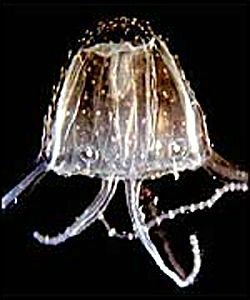Irukandji Jellyfish
The Irukandji Jellyfish (Carukia barnesi) inhabits waters of Australia. This is a deadly jellyfish, which is only 2.5 centimeters (with bell and tentacles) in diameter, which makes it difficult to spot.
The Irukandji is believed to be the most venomous creature in the world
The term Irukandji refers to an Australian Aboriginal tribe that inhabited the Palm Cove region of northern Queensland where the Irukandji syndrome, produced by the irukandji stings poison, occurs most often.
This is a species of jellyfish that has been known about in recent years, due to deaths of swimmers in Australia. In 2002, Richard Jordon stung while swimming off the coast of de Hamilton. He was a British tourist 58 years old, unfortunately he died a few days later.
This species of deadly jellyfish is related to another deadly jellyfish, Meduse Della box.
The jellyfish itself was identified in 1964 by Dr. Jack Barnes.
Irukandji has stingers not only on its tentacles but also on its bell.
Irukandji is very small and fragile, it cannot be kept in a normal aquarium because if they hit the side the impact will kill it.
The first Irukandji jellyfish in captivity borned in Townsville.
Irukandji Jellyfish antivenom and treatment
Doctors believe they may have found an effective treatment for people stung by deadly irukandji jellyfish.
They are cautiously optimistic with these treatment results
Dr. Michael Corkeron of the Townsville Hospital Intensive Care Unit has discovered a remarkably simple yet effective treatment for the potentially fatal stings of the venomous irukandji jellyfish.
Dr. Corkeron has successfully treated patients with magnesium infusions delivered by intravenous drip. Doctors in Queensland say magnesium infusion can fight the jellyfish's lethal venom.
The treatment has been tested on pigs. Doctors have now reported success in humans.
Dr Michael Corkeron, director of intensive care at the state's Townsville Hospital, said:
"The remarkable thing is that magnesium infusion is a long-established, very safe and inexpensive treatment."
Townsville Hospital Contact:http://www.health.qld.gov.au/comments.asp For Australia: In a life threatening emergency DIAL 000 for Fire, Police & Ambulance Services in Australia.
Irukandji Jellyfish First Aid
 Victims frequently require hospitalization to receive analgesics and sometimes intravenous antihypertensive therapy; alpha-blocking agents such as phentolamine have been used for this purpose. Supraventricular tachycardia and high-intensity transient signals in dilated cardiomyopathy have been reported following Irukandji stings, and it has been suggested that serial echocardiography be performed to monitor the progress of severely affected patients. Analgesia is usually required, and may need to be given intravenously when pain is severe. First aid consists of analgesia then examination and investigation followed by reassurance. The role of vinegar to inactivate undischarged nematocysts remains uncertain, with initial work proving inconclusive.
Victims frequently require hospitalization to receive analgesics and sometimes intravenous antihypertensive therapy; alpha-blocking agents such as phentolamine have been used for this purpose. Supraventricular tachycardia and high-intensity transient signals in dilated cardiomyopathy have been reported following Irukandji stings, and it has been suggested that serial echocardiography be performed to monitor the progress of severely affected patients. Analgesia is usually required, and may need to be given intravenously when pain is severe. First aid consists of analgesia then examination and investigation followed by reassurance. The role of vinegar to inactivate undischarged nematocysts remains uncertain, with initial work proving inconclusive.
Irukandji syndrome:
The Irukandji's sting causes symptoms which are collectively known as "Irukandji syndrome". The Irukandji syndrome Symptoms were first documented by Hugo Flecker in 1952. Every summer, more than sixty people are hospitalized with this potentially fatal syndrome.
Irukandji syndrome symptoms:
Catastrophic complex of clinical signs and symptoms.The initial sting is typically mild and is followed, minutes to hours later, by vomiting, profuse sweating, headache, agitation, rapid heart rate and very high blood pressure. The increase in blood pressure may be life-threatening and can be associated with abnormal heart beat and heart failure. The symptoms may last from hours to several days, and victims usually require hospitalisation. Though the syndrome was first described almost fifty years ago, its pharmacological basis and a specific treatment have eluded investigators.
In rare cases, the victim suffers pulmonary oedema which could be fatal if not treated.
Where lives the Irukandji Jellyfish
 The Irukandji jellyfish has been seen in Fraser Island, an island in northern Queensland, 250 kilometres north of Brisbane.
The Irukandji jellyfish has been seen in Fraser Island, an island in northern Queensland, 250 kilometres north of Brisbane.
The syndrome has also been described throughout the Pacific and recently from waters of Florida.
Dr Seymour (James Cook University) said the tourist industry should be warning people about the jellyfish because Global warming may be changing water temperatures allowing the dangerous Irukandji jellies to live in new areas including some tourist destinations.
Irukandji attack prevention
 Lycra stinger suits.
Lycra stinger suits.
Some beaches erect enclosures ,stinger nets, but Irukandji can still filter through the net.
Take the right precautionsm, you can take steps to minimize the impact of the danger and still enjoy all the wonderful beauty of the reef.
Talk specialised dive operators.
Irukandji Jellyfish in Newspapers:
BRISBANE medical student is recovering in hospital in north Queensland after being stung on the neck by an irukandji jellyfish. Sean Bills, 26, was celebrating the completion of his degree with fellow students from the University of Queensland when he was stung while swimming off Hayman Island in the Whitsunday group. "The first thing was the sting which just came down around my neck,'' Mr Bills told the Seven Network from his hospital bed in Mackay.He said he will never again go swimming in waters off north Queensland during the stinger season, which runs from October to May.(news.com, November 30, 2007 )
Irukandji Jellyfish in Movies:
Fool's Gold movie delayed for Irukandji jellyfish in 2007.
In an episode of .








